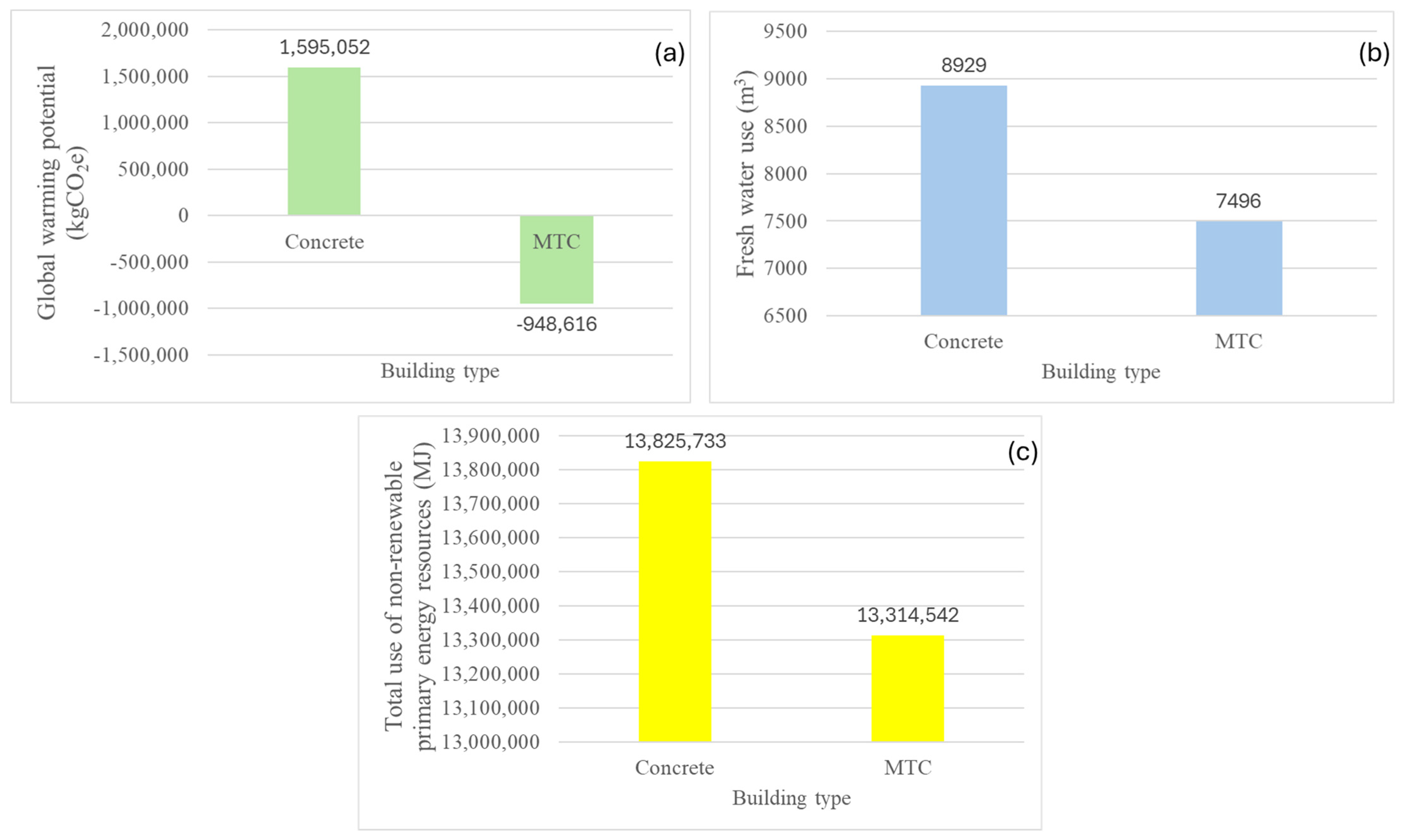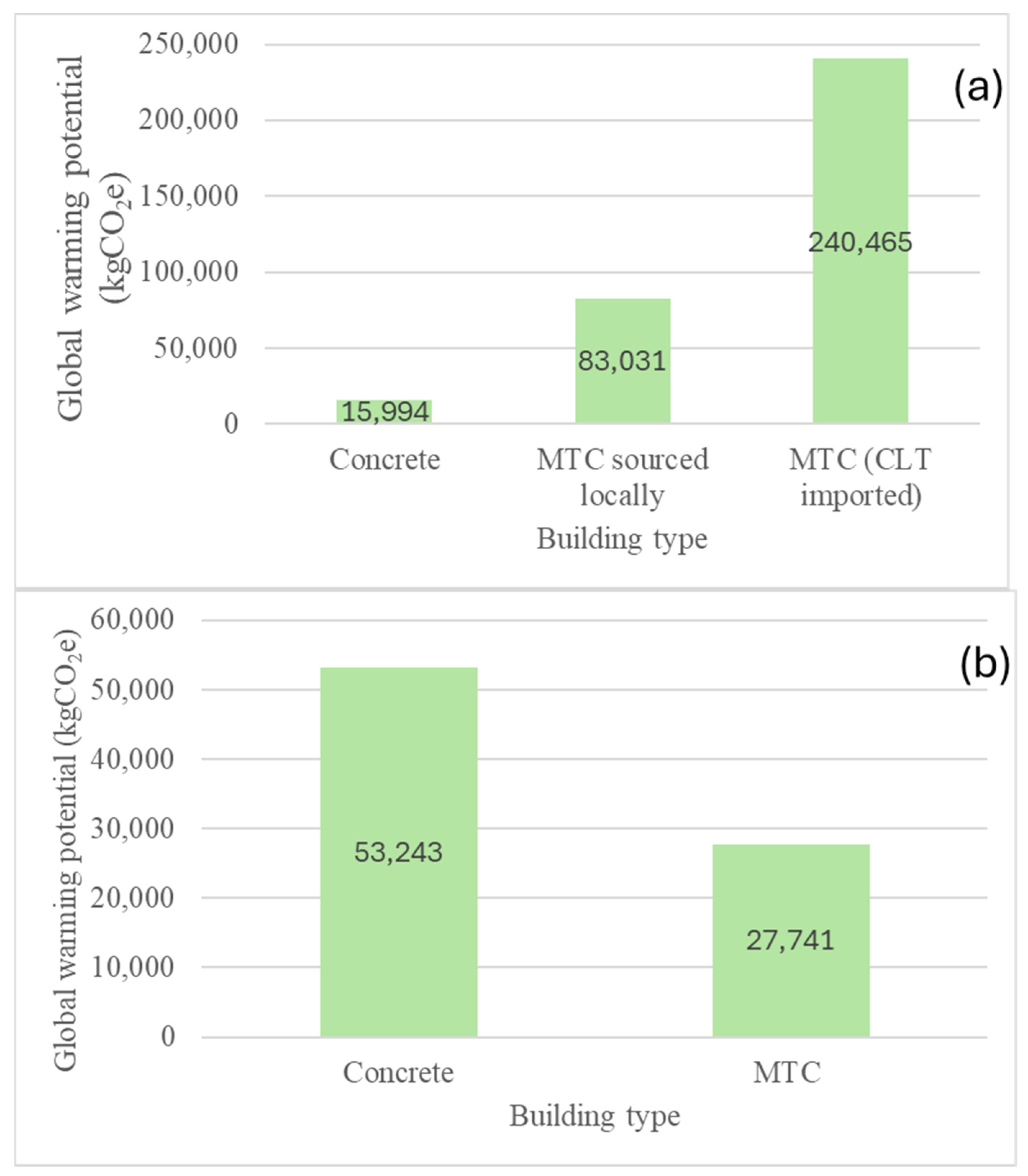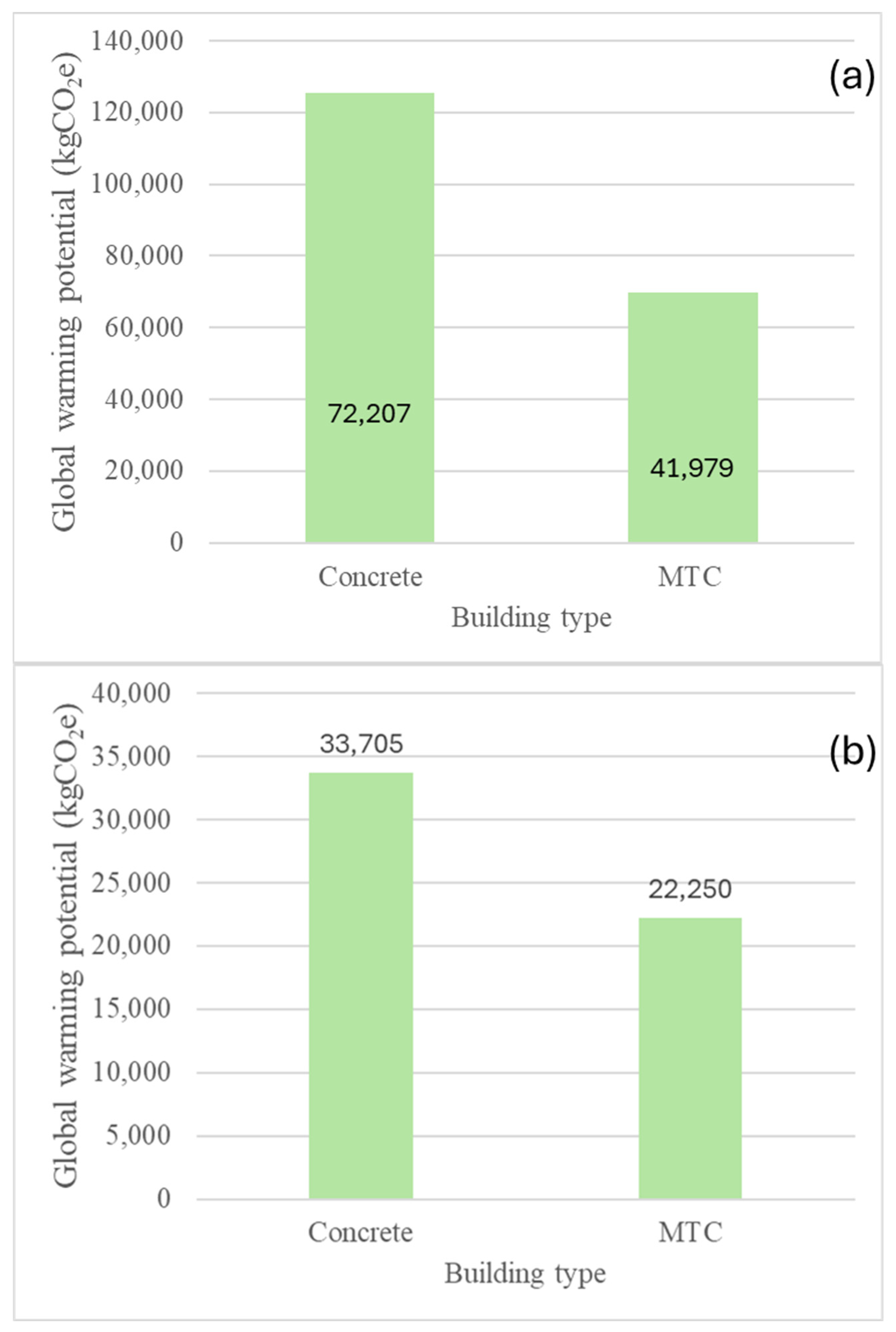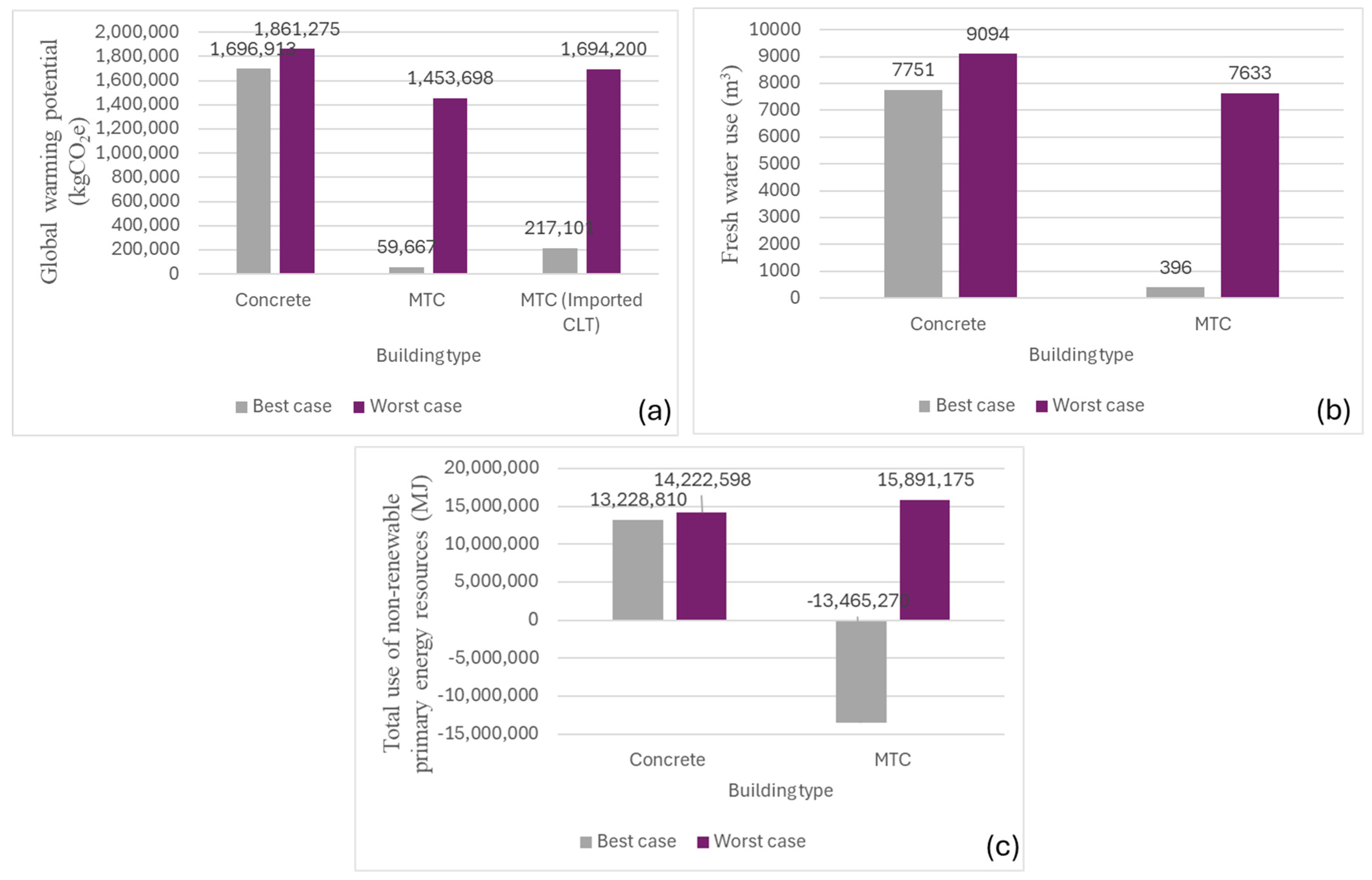Life Cycle Assessment and Cost Analysis of Mid-Rise Mass Timber vs. Concrete Buildings in Australia
Abstract
:1. Introduction
- To quantify and compare the environmental and costs impacts of MTC vs. traditional concrete and steel builds for mid-rise structures using a cradle-to-cradle life cycle approach;
- To identify critical stages of the building’s life cycle where environmental and cost impacts are most significant, and inform the competitiveness of mid-rise mass timber buildings in the construction industry and promote their adoption in Australia.
2. Materials and Methods
2.1. Product Stage
2.2. Construction Stage
2.3. Use Stage
2.4. End-of-Life Stage
2.5. Totals
2.6. Cost Analysis
3. Results
3.1. Product Stage
3.2. Construction Stage
3.3. End-of-Life Stage
3.4. Totals
3.5. Cost Analysis
4. Discussion
4.1. Product Stage
4.2. Transport and Construction Stage
4.3. End-of-Life Stage
4.4. Costs
4.5. Limitations
5. Conclusions
Author Contributions
Funding
Institutional Review Board Statement
Informed Consent Statement
Data Availability Statement
Conflicts of Interest
References
- World Green Building Council. Bringing Embodied Carbon Upfront. Available online: https://worldgbc.org/advancing-net-zero/embodied-carbon/ (accessed on 17 October 2023).
- United Nations Human Settlements Programme (UN-Habitat). Urban Planning Law for Climate Smart Cities: Urban Law Module of the Law and Climate Change Toolkit. Available online: https://unhabitat.org/urban-planning-law-for-climate-smart-cities-the-urban-law-module-of-the-law-and-climate-change (accessed on 15 October 2023).
- Pandit, J.K.; Watson, M.; Qader, A. Reduction of Greenhouse Gas Emissions in Steel Production; CO2CRC Ltd.: Melbourne, Australia, 2020. [Google Scholar]
- Supriya; Chaudhury, R.; Sharma, U.; Thapliyal, P.C.; Singh, L.P. Low-CO2 emission strategies to achieve net zero target in cement sector. J. Clean. Prod. 2023, 417, 137466. [Google Scholar] [CrossRef]
- Crawford, R.H.; Cadorel, X. A Framework for assessing the Environmental Benefits of Mass Timber Construction. Procedia Eng. 2017, 196, 838–846. [Google Scholar] [CrossRef]
- Yu, M.; Wiedmann, T.; Crawford, R.; Tait, C. The Carbon Footprint of Australia’s Construction Sector. Procedia Eng. 2017, 180, 211–220. [Google Scholar] [CrossRef]
- Department of Climate Change, Energy, the Environment and Water. Government Priorities: Buildings. Available online: https://www.energy.gov.au/government-priorities/buildings#:~:text=Data%20from%20the%20department%20shows,businesses%20and%20the%20wider%20economy (accessed on 17 September 2023).
- Harte, M.A. Mass timber—The emergence of a modern construction material. J. Struct. Integr. Maint. 2017, 2, 121–132. [Google Scholar] [CrossRef]
- Abed, J.; Rayburg, S.; Rodwell, J.; Neave, M. A review of the Performance and Benefits of Mass Timber as an Alternative to Concrete and Steel for Improving the Sustainability of Structures. Sustainability 2022, 14, 5570. [Google Scholar] [CrossRef]
- Architecture and Design. Forte by Lend Lease. Available online: https://www.architectureanddesign.com.au/projects/multi-residential/forte-by-lend-lease (accessed on 8 October 2023).
- Wood Solutions Mid-Rise. Available online: https://www.woodsolutions.com.au/case-studies/mid-rise?page=0 (accessed on 17 October 2023).
- Australian Building Codes Board (ABCB). National Construction Code Volume One, NCC. 2019. Available online: https://ncc.abcb.gov.au/editions/2019/ncc-2019-volume-one (accessed on 22 July 2024).
- Hill, S.; Cumpston, Z.; Quintana Vigiola, G. Australia State of the Environment 2021: Urban Independent Report to the Australian Government Minister for the Environment. Available online: https://soe.dcceew.gov.au/sites/default/files/2022-07/soe2021-urban.pdf (accessed on 17 October 2023).
- Milman, O. Melbourne’s Urban Sprawl: Just How Big Can the City Get? Available online: https://www.theguardian.com/australia-news/2015/sep/03/melbournes-urban-sprawl-just-how-big-can-the-city-get (accessed on 28 October 2023).
- Clean Energy Finance Corporation/CEFC Timber Building Program. Available online: https://www.cefc.com.au/insights/investment-insights/cefc-timber-building-program/ (accessed on 17 October 2023).
- Built Offsite Australia Leads the World in Tall Mass Timber Buildings. Available online: https://builtoffsite.com.au/news/mass-timber/ (accessed on 17 September 2023).
- Green Building Council of Australia Mid-Tier Commercial Office Buildings in Australia, Green Building Council of Australia. Available online: https://www.gbca.org.au/uploads/97/36449/Mid-tier%20Commercial%20Office%20Buildings%20Sector%20Report_FINAL.pdf (accessed on 17 September 2023).
- Zaman, A.; Chan, Y.Q.; Jonescu, E.; Stewart, I. Critical Challenges and Potential for Widespread Adoption of Mass Timber Construction in Australia—An Analysis of Industry Perceptions. Buildings 2022, 12, 1405. [Google Scholar] [CrossRef]
- XLAM Our State of the Art Production Facility. Available online: https://xlam.co/our-facilities (accessed on 17 September 2023).
- Wood Solutions Cross Laminated Timber. Available online: https://www.woodsolutions.com.au (accessed on 17 September 2023).
- Gu, H.; Liang, S.; Pierobon, F.; Puettmann, M.; Ganguly, I.; Chen, C.; Pasternack, R.; Wishnie, S.; Maples, I. Mass Timber Building Life Cycle Assessment Methodology for the U.S. Regional Case Studies. Sustainability 2021, 13, 14034. [Google Scholar] [CrossRef]
- EN15978:2011; CEN/TC 350. Sustainability of Construction Works—Assessment of Environmental Performance of Buildings—Calculation Method. BSI Standards: London, UK, 2011.
- EN 15804:2012 + A1: 2013/FprA2:2019; CEN/TC 350. Sustainability of Construction Works—Environmental Product Declarations—Core Rules for the Product Cate-Gory of Construction Projects. 2019. Available online: https://www.usgbc.org/resources/en-15804%E2%80%942012-sustainability-construction-works-environmental-product-declarations-core-ru (accessed on 22 July 2024).
- Environmental Product Declaration: Boral Victoria Region—Pre-Mix Concrete. Available online: https://epd-australasia.com/epd/boral-victoria-region-pre-mix-concrete-epd/ (accessed on 9 May 2024).
- Environmental Product Declaration for Barro Group Pre-Mix Concrete. Available online: https://epd-australasia.com/epd/barro-group-pre-mix-concrete/ (accessed on 9 May 2024).
- Adbri Concrete Products EPD—Victoria. Available online: https://epd-australasia.com/epd/adbri-concrete-products-victoria/ (accessed on 9 May 2024).
- Forest and Wood Products Australia Environmental Product Declaration: Glued Laminated Timber (Glulam). Available online: https://epd-australasia.com/wp-content/uploads/2018/03/epd565-Glued-Laminated-Timber-v1.pdf (accessed on 8 May 2024).
- Environmental Product Declaration—Reinforcing Bar and Mesh. Available online: https://epd-australasia.com/epd/steel-reinforcing-bar-and-mesh/ (accessed on 9 May 2024).
- Environmental Product Declaration for Rondo Products: Ceiling, Wall Framing and Finishing. Available online: https://epd-australasia.com/company-epd/rondo/ (accessed on 9 May 2024).
- XLam Australia Environmental Product Declaration: XLam CLT Panel. Available online: https://epd-australasia.com/wp-content/uploads/2021/03/SP02326-XLam-EPD_v1.1_Jun23.pdf (accessed on 8 May 2024).
- Siniat Plasterboard Environmental Product Declaration. Available online: https://epd-australasia.com/epd/siniat-plasterboard/ (accessed on 9 May 2024).
- Insulated Wall and Roof Panels with a PIR Core. Available online: https://epd-australasia.com/epd/metecno-insulated-wall-and-roof-panels-with-a-pir-core/ (accessed on 9 May 2024).
- Decorative Acoustic, Acoustic and Thermal Insulation Products Manufactured by CSR Martini. Available online: https://epd-australasia.com/epd/decorative-acoustic-acoustic-and-thermal-insulation-products-manufactured-by-csr-martini/ (accessed on 9 May 2024).
- Green Building Council Australia. Upfront Carbon Emissions Calculation Guide—Interim. Available online: https://new.gbca.org.au/resources/reports-and-publications/#guides (accessed on 10 May 2024).
- Ecotera High Performance/Low Carbon Concrete (Victoria—Melbourne Metro). Available online: https://epd-australasia.com/epd/ecotera-high-performance-low-carbon-concrete-victoria-melbourne-metro/ (accessed on 9 May 2024).
- Durlinger, B.; Crossin, E.; Wong, J. Life Cycle Assessment of a Cross Laminated Timber Building. Available online: https://fwpa.com.au/wp-content/uploads/2013/02/PRA282-1112_Life-Cycle_Assessment_of_a_cross_laminated_timber_building_0.pdf (accessed on 4 May 2024).
- Carboncare. CO2 Emissions Calculator. Available online: https://www.carboncare.org/en/co2-emissions-calculator (accessed on 23 April 2024).
- Greene, J.; Hosanna, R.; Willson, B.; Quinn, J. Whole life embodied emissions and net-zero emissions potential for a mid-rise office building constructed with mass timber. Sustain. Mater. Technol. 2023, 35, e00528. [Google Scholar] [CrossRef]
- Australian Government Department of Climate Change, Energy, the Environment and Water. Australian National Greenhouse Accounts Factor. Available online: https://www.dcceew.gov.au/climate-change/publications/national-greenhouse-accounts-factors-2023 (accessed on 10 May 2024).
- Leedham, A.; Heppner, J.; Smith, M.; Cooke, T. Lever Architecture and Atelier Ten Mythbusting Mass Timber. Available online: https://www.architecturalrecord.com/ext/resources/Issues/2023/06-June/Mythbusting-Mass-Timber.pdf (accessed on 14 April 2024).
- AusLCI Carbon Emission Factors. Available online: https://www.alcas.asn.au/auslci-emissions-factors (accessed on 9 May 2024).
- Environmental Product Declaration—Ready-Mix Concrete. Available online: https://epd-australasia.com/epd/bgc-concrete-ready-mix-concrete/ (accessed on 9 May 2024).
- Environmental Product Declaration—Crumb Rubber Underlay. Available online: https://www.environdec.com/library/epd7910 (accessed on 10 May 2024).
- Eslami, H.; Yaghma, A.; Jayasinghe, L.; Waldmann, D. Comparative life cycle assessment of light frame timber and reinforced concrete masonry structural systems for single-family houses in Luxembourg. Heliyon 2024, 10, e26083. [Google Scholar] [CrossRef] [PubMed]
- Duan, Z.; Huang, Q.; Sun, Q.; Zhang, Q. Comparative life cycle assessment of a reinforced concrete residential building with equivalent cross laminated timber alternatives in China. J. Build. Eng. 2022, 62, 105357. [Google Scholar] [CrossRef]
- Wood Solutions Rethinking Apartment Building Construction—Consider Timber. Available online: https://www.woodsolutions.com.au/publications/rethinking-construction-consider-timber (accessed on 5 May 2024).
- Norman, C.; Kreye, M. PennState Extension How Forests Store Carbon. Available online: https://extension.psu.edu/how-forests-store-carbon (accessed on 6 May 2024).
- Ong, C.B. 7- Glue-laminated timber (glulam). Wood Compos. 2015, 123–140. [Google Scholar] [CrossRef]
- Australian Sustainable Hardwoods T3 Collingwood the Pinnacle of Mass Timber Architecture. Available online: https://ash.com.au/projects/t3-collingwood-the-pinnacle-of-mass-timber-architecture/ (accessed on 4 May 2024).
- Scouse, A.; Kelly, S.S.; Liang, S.; Bergman, R. Regional and net economic impacts of high-rise mass timber construction in Oregon. Sustain. Cities Soc. 2020, 61, 102154. [Google Scholar] [CrossRef]
- Nepal, P.; Johnston, C.; Ganguly, I. Effects on global forests and wood product markets of increased demand for mass timber. Sustainability 2021, 13, 13943. [Google Scholar] [CrossRef]
- Australian Forests Products Association Inquiry into the Timber Supply Chain Constraints in the Australian Plantation Sector Submission. Available online: https://www.aph.gov.au/DocumentStore.ashx?id=8c3b3763-f9ac-49e1-8a77-1dc036adb8b3andsubId=6909899 (accessed on 7 May 2024).
- Australian Bureau of Agriculture and Resource Economics and Sciences Australian Plantation Statistics 2023. Available online: https://www.agriculture.gov.au/abares/research-topics/forests/forest-economics/plantations-update#download-the-overview-report-and-datasets (accessed on 7 May 2024).
- McGavin, R.L.; Dakin, T.; Shanks, J. Mass-timber construction in Australia: Is CLT the only answer? BioResources 2020, 15, 4642–4645. [Google Scholar] [CrossRef]
- Duan, Z.; Huang, Q.; Zhang, Q. Life cycle assessment of mass timber construction: A review. Build. Environ. 2022, 221, 109320. [Google Scholar] [CrossRef]
- AS3600:2018; Concrete Structures. Standards Australia: Sydney, NSW, Australia, 2018.
- Zgonc, B.; Tekavcic, M.; Jaksic, M. The impact of distance on mode choice in freight transport. Eur. Transp. Res. Rev. 2019, 11, 10. [Google Scholar] [CrossRef]
- Collier, S.; Ruehl, C.; Yoon, S.; Boriboonsomsin, K.; Durbin, T.; Scora, G.; Johnson, K.; Herner, J. Impact of heavy-duty diesel truck activity on fuel consumption and its implications for the reduction of greenhouse gas emissions. J. Transp. Res. Board 2019, 2673, 125–135. [Google Scholar] [CrossRef]
- Sanchez-Balseca, J.; Pineiros, J.; Perez-Foguet, A. Influence of travel time on carbon dioxide emissions from urban traffic. Transp. Res. Part D Transp. Environ. 2023, 118, 103698. [Google Scholar] [CrossRef]
- Allan, K.; Phillips, A. Comparative cradle-to-grave life cycle assessment of low and mid-rise mass timber buildings with equivalent structural steel alternatives. Sustainability 2021, 13, 3401. [Google Scholar] [CrossRef]
- Liang, S.; Gu, H.; Bergman, R. Environmental life-cycle assessment and life-cycle cost analysis of a high-rise mass timber building: A case study in pacific northwestern united states. Sustainability 2021, 13, 7831. [Google Scholar] [CrossRef]
- Hafner, A.; Rueter, S. Method for assessing the national implications of environmental impacts from timber buildings-an exemplary study for residential buildings in Germany. Wood Fibre. Sci. 2018, 50, 139–154. [Google Scholar] [CrossRef]
- Hart, J.; Pomponi, F. More timber in construction: Unanswered questions and future challenges. Sustainability 2020, 12, 3473. [Google Scholar] [CrossRef]
- Ximenes, F.; Gardner, W.; Cowie, A. The decomposition of wood products in landfills in Sydney, Australia. Watse. Manag. 2008, 28, 2344–2354. [Google Scholar] [CrossRef]
- Robati, M.; Oldfield, P. The embodied carbon of mass timber and concrete buildings in Australia; An uncertainty analysis. Build. Environ. 2022, 214, 108944. [Google Scholar] [CrossRef]
- Evison, C.; Kremer, D.; Guiver, J. Mass timber construction in Australia and New Zealand-status, and economic and environmental influences on adoption. Spec. Issue—CLT/Mass Timber 2018, 50, 128–138. [Google Scholar] [CrossRef]
- Smith, T.; Fragiacomo, M.; Pampanin, S.; Buchanan, A. Construction time and cost for post-tensioned timber buildings. Constr. Mater. 2009, 162, 141–149. [Google Scholar] [CrossRef]





| Stage | Purpose | Source |
|---|---|---|
| A1–A3 | Bill of Materials | Gu et al. [21]. |
| Concrete | EPD Australasia—Average of Boral, Barro and Adbri [24,25,26]. | |
| Glulam | EPD Australasia—Wood Solutions [27]. | |
| Rebar | EPD Australasia—Australian Reinforcing company [28] | |
| Steel stud (1.15 mm, #681) | EPD Australasia—Rondo [29] | |
| CLT | EPD Australasia—Xlam [30] | |
| Gypsum Board (Fireshield 13 mm) | EPD Australasia—Siniat—plasterboard [31] | |
| Foam insulation | EPD Australasia—Metecno [32] | |
| Acoustic insulation (Absorb black 25 mm) | EPD Australasia—Martini [33] | |
| A4 | Truck carbon emissions calculator | Greenstar [34] |
| Concrete transportation | EPD Australasia—Hanson [35] | |
| Imported CLT transportation | Durlinger et al. [36], carboncare.org [37] | |
| Glulam transportation | EPD Australasia—Woodsolutions [27] | |
| A5 | Total diesel equation | Greene et al. [38] |
| Diesel GWP coefficient | Department of Climate Change, Energy the Environment and Water [39] | |
| C1 | MTC vs. concrete demolition | Duan et al. [40] |
| C2 | Transport to waste disposal | AusLCI Carbon Emission Factors [41] |
| C3−D | Concrete | EPD Australasia—BGC Concrete [42] |
| Glulam | EPD Australasia—Wood Solutions [27] | |
| Rebar | EPD Australasia—Australian Reinforcing Company [28] | |
| Steel stud | EPD Australasia—Rondo [29] | |
| CLT | EPD Australasia—Xlam [30] | |
| Gypsum board | EPD Australasia—Siniat [31] | |
| Acoustic insulation | EPD International—Interfloor crumb rubber underlay EPD [43] |
| Assembly | Material | MTC Quantity | Concrete Quantity | Unit |
|---|---|---|---|---|
| Columns and Beams | Concrete 40 MPa | n/a | 93 | m3 |
| Glulam | 140 | n/a | m3 | |
| Rebar | n/a | 59 | tonnes | |
| Exterior Walls | Steel stud | n/a | 738 | kg |
| CLT | 172 | n/a | m3 | |
| 13 mm Gypsum board | 1638 | 1638 | m2 | |
| 70 mm Foam insulation | n/a | 1638 | m2 | |
| Floors | 25 mm Acoustic insulation | 4115 | n/a | kg |
| CLT | 1437 | n/a | m3 | |
| Concrete 40 MPa | 790 | 2293 | m3 | |
| Rebar | 5 | 42 | tonnes | |
| Foundation | Concrete 40 MPa | 367 | 674 | m3 |
| Rebar | 12 | 20 | tonnes | |
| Interior Walls | CLT | 1152 | n/a | m3 |
| Concrete 40 MPa | n/a | 516 | m3 | |
| 13 mm Gypsum board | 13,724 | 24,041 | m2 | |
| Rebar | n/a | 73 | tonnes | |
| Steel stud | 8112 | 16,302 | kg |
| Assembly | MTC | Concrete | Variance |
|---|---|---|---|
| Columns and beams | $34,935 | $365,644 | −$330,709 |
| Exterior walls | $518,082 | $416,165 | $101,917 |
| Floors | $2,539,961 | $1,810,398 | $729,563 |
| Foundation | $364,350 | $537,441 | −$173,091 |
| Interior walls | $1,286,436 | $1,224,522 | $61,914 |
| Roof | $233,100 | $356,617 | −$123,517 |
| Ceiling finishes | $0 | $459,085 | −$459,085 |
| Termite protection | $25,000 | $0 | $25,000 |
| Construction costs (labour, etc.) | $2,392,000 | $2,704,000 | −$312,000 |
| Total | $7,393,864 | $7,873,872 | −$480,008 |
Disclaimer/Publisher’s Note: The statements, opinions and data contained in all publications are solely those of the individual author(s) and contributor(s) and not of MDPI and/or the editor(s). MDPI and/or the editor(s) disclaim responsibility for any injury to people or property resulting from any ideas, methods, instructions or products referred to in the content. |
© 2024 by the authors. Licensee MDPI, Basel, Switzerland. This article is an open access article distributed under the terms and conditions of the Creative Commons Attribution (CC BY) license (https://creativecommons.org/licenses/by/4.0/).
Share and Cite
Jolly, R.; Fairweather, H.; Rayburg, S.; Rodwell, J. Life Cycle Assessment and Cost Analysis of Mid-Rise Mass Timber vs. Concrete Buildings in Australia. Sustainability 2024, 16, 6465. https://doi.org/10.3390/su16156465
Jolly R, Fairweather H, Rayburg S, Rodwell J. Life Cycle Assessment and Cost Analysis of Mid-Rise Mass Timber vs. Concrete Buildings in Australia. Sustainability. 2024; 16(15):6465. https://doi.org/10.3390/su16156465
Chicago/Turabian StyleJolly, Riley, Holly Fairweather, Scott Rayburg, and John Rodwell. 2024. "Life Cycle Assessment and Cost Analysis of Mid-Rise Mass Timber vs. Concrete Buildings in Australia" Sustainability 16, no. 15: 6465. https://doi.org/10.3390/su16156465





